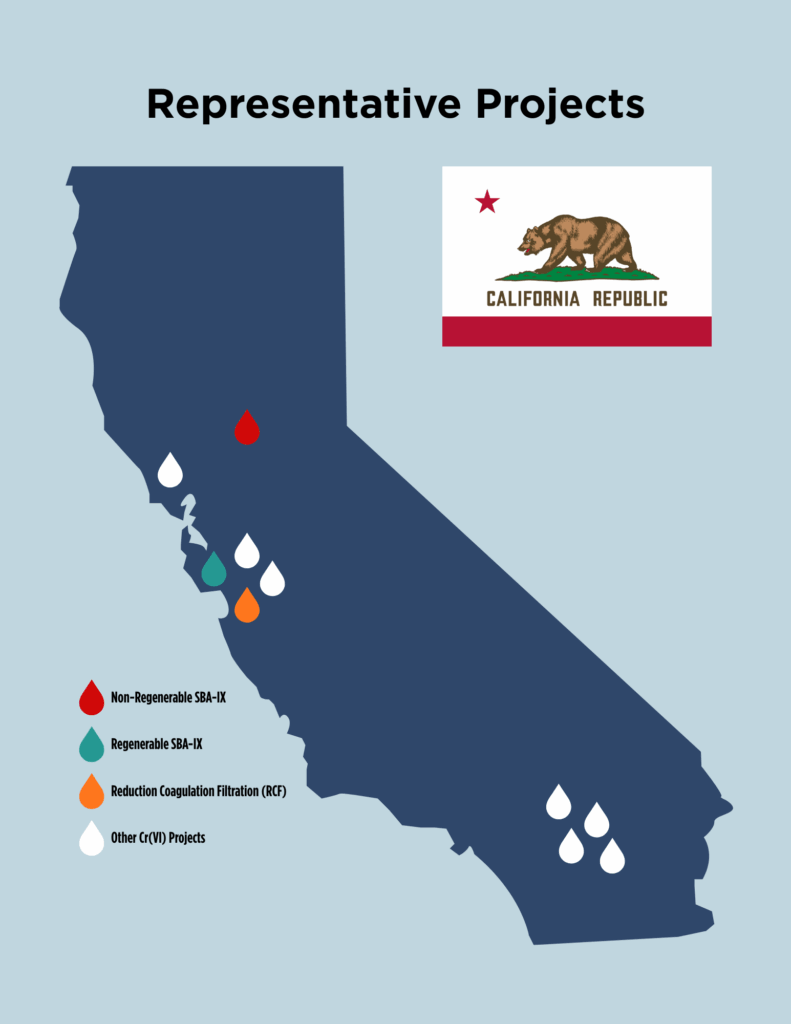Hexavalent Chromium Services
Corona Environmental Consulting has led the way in assisting drinking water utilities with hexavalent chromium treatment and compliance.
Corona in partnership with our clients have pushed the boundaries of hexavalent chromium [Cr(VI)] treatment for public water systems with bench- and pilot-scale testing, design, permitting and implementation for first-of-their kind full-scale permitted treatment systems for Cr(VI) removal.
Whether your utility began initial monitoring this year or has already evaluated potential treatment options, our professional staff are here to partner with you. Backed by a team of expert engineers with deep experience in water treatment technologies, Corona delivers practical, innovative solutions tailored to your community’s needs.
Non-Regenerable SBA-IX ⌄
California American Water (CAW) has seven groundwater wells above the 10 μg/ Cr(VI) MCL. Corona investigated compliance strategies including blending, well modification, and treatment alternatives. This desktop evaluation identified SBA-IX as CAW’s most effective compliance solution, which was then confirmed via site specific pilot testing. The water quality of CAW’s Cr(VI) impacted wells are ideally suited for SBA-IX treatment since the background water quality matrix, specifically nitrate and sulfate, are relatively low. However, CAW’s wells are generally located on small parcels which would make the implementation of this treatment difficult if not impossible without the acquisition of additional property. In response to this constraint, Corona recommended SBA-IX be implemented in a non-regenerable mode, which to our knowledge has yet to be permitted in California for this purpose. Corona has since assisted with the procurement, design, and permitting of the full-scale installations which began operating in 2017.
Regenerable SBA-IX ⌄
Chromium Treatment Implementation Support, Soquel Creek Water Service District, CA: The Soquel Creek Water District has been actively addressing their Cr(VI) impacted sources since 2013. Craig assisted the District with a preliminary treatment technology evaluation which identified strong base anion exchange (SBA-IX) as the most appropriate Cr(VI) technology. The outcome of this project prompted the District to participate in a Water Research Foundation Tailored Collaboration study that investigated SBA-IX performance for Cr(VI) treatment at bench- and pilot-scale. The results of the Tailored Collaboration study demonstrated exceptional Cr(VI) capacity using SBA-IX and confirmed the recommendation of SBA-IX from the initial technology screening. This also prompted the District to move ahead with a full-scale demonstration of the SBA-IX technology at the San Andreas well until a permanent facility could be designed and constructed. The District has placed their Cr(VI) activities since the MCL was rescinded, but is expected to resume these efforts when the MCL is reestablished.
Reduction Coagulation Filtration (RCF) ⌄
California Water Service had a well in their Las Lomas system with existing iron and manganese treatment that also required treatment for hexavalent chromium (CrVI). Novel on-site pilot testing was conducted to determine if the existing system could be retro-fitted and optimized to simultaneously remove Cr(VI) and manganese. The successful pilot testing conducted at this site found that the reduction time, traditionally thought to take upwards of 45 minutes, could be reduced to less than 2 minutes, substantially reducing the cost and footprint of the process and increasing its applicability to utilities across the state of California. This discovery saved rate payers nearly $1M in capital costs and led to the installation of the first full scale RCF treatment unit for Cr(VI) removal. Corona developed the basis of design for this project and the detailed design and procurement was led by California Water Service Staff. Corona also led the start-up, permitting and development of the Operations and Maintenance plan for the treatment system.

Corona's Cr(VI) Experts
Chad Seidel, Ph.D., P.E.
Chad has been assisting Cr(VI) impacted water utilities in California since 2000. His 2006 Ph.D. dissertation, “Investigation of Hexavalent Chromium as a Future Regulated Drinking Water Contaminant” informed questions about occurrence, treatment options, costs, and regulatory policy. He has led the discovery, testing, and implementation of Cr(VI) treatment advances regarding strong base anion exchange, reduction coagulation filtration, and others to achieve substantial cost savings for impacted utilities. He’s authored over a dozen peer reviewed references on these subjects.
303-544-2161 X 123
Craig Gorman, P.E.
and Treatment
Craig has nearly 20 years of experience dedicated to the treatment of contaminants in groundwater. Craig has led technology selections, bench- and pilot-scale evaluations, cost estimating and design efforts for contaminants including hexavalent chromium, arsenic, nitrate, fluoride, uranium, and radium.
303-544-2161 X 403
Brittany Gregory, P.Eng
Brittany focuses on treatment process optimization through bench- and pilot scale testing and water quality modeling. She also has extensive experience in distribution system water quality, data management, data visualization, and process modeling. Recently, Brittany has been helping utilities in California on their path for compliance with hexavalent chromium and per- and polyfluoroalkyl substances.
303-544-2161 X 423
